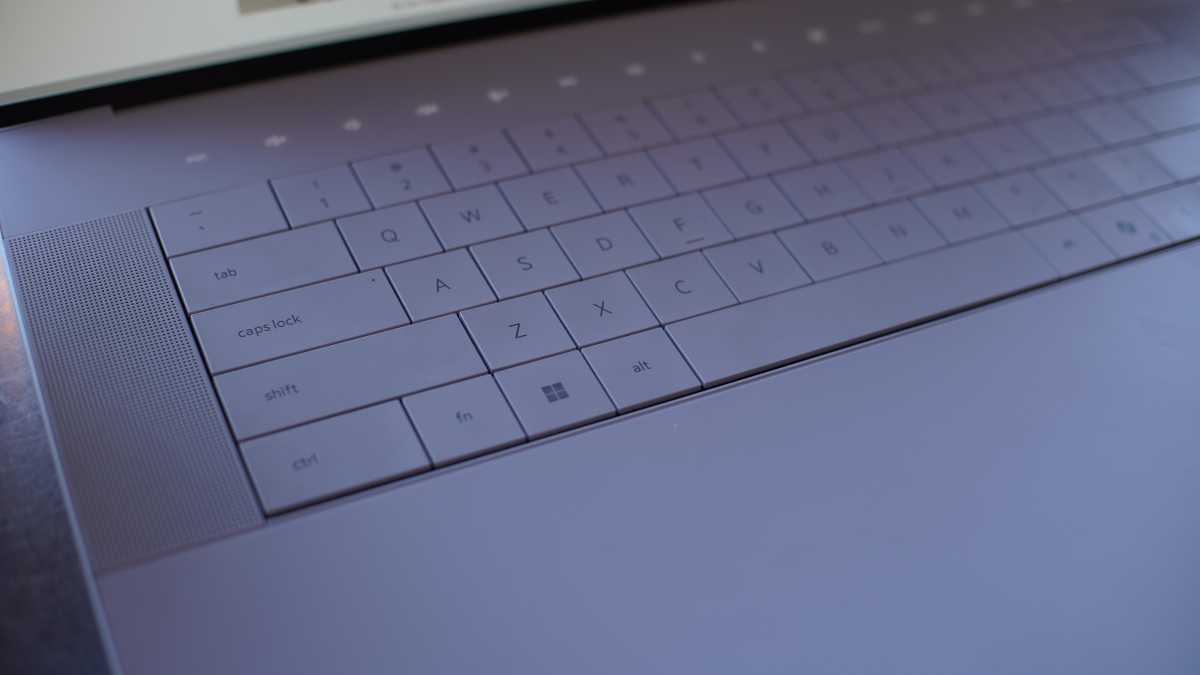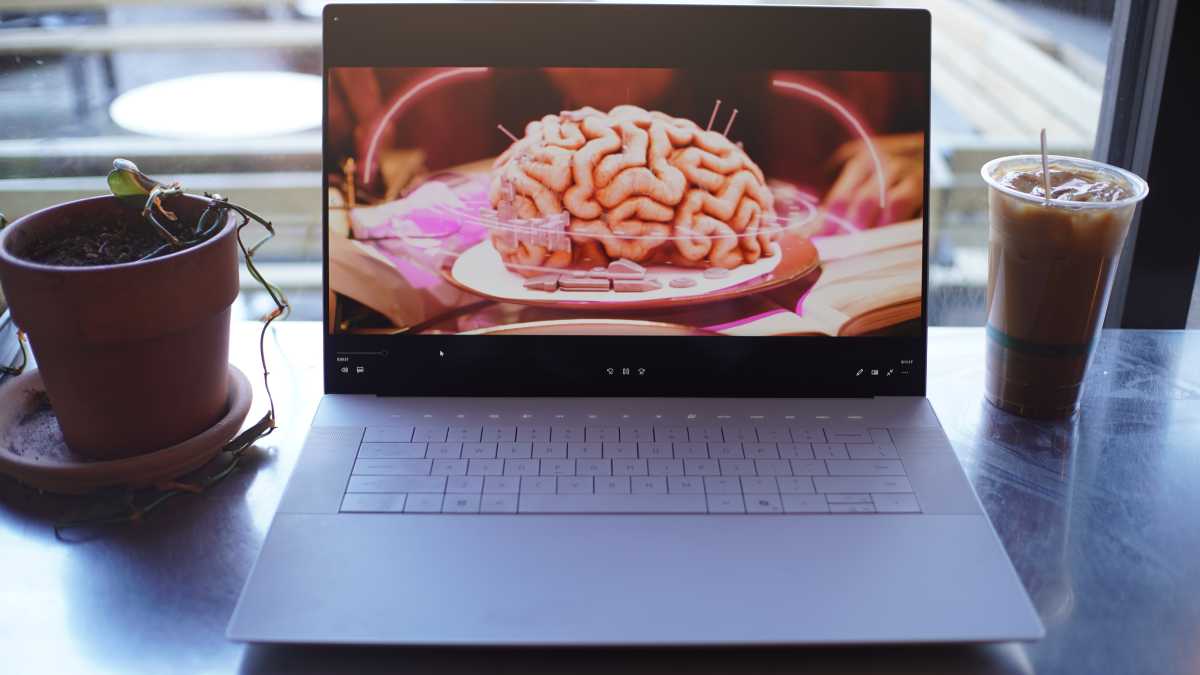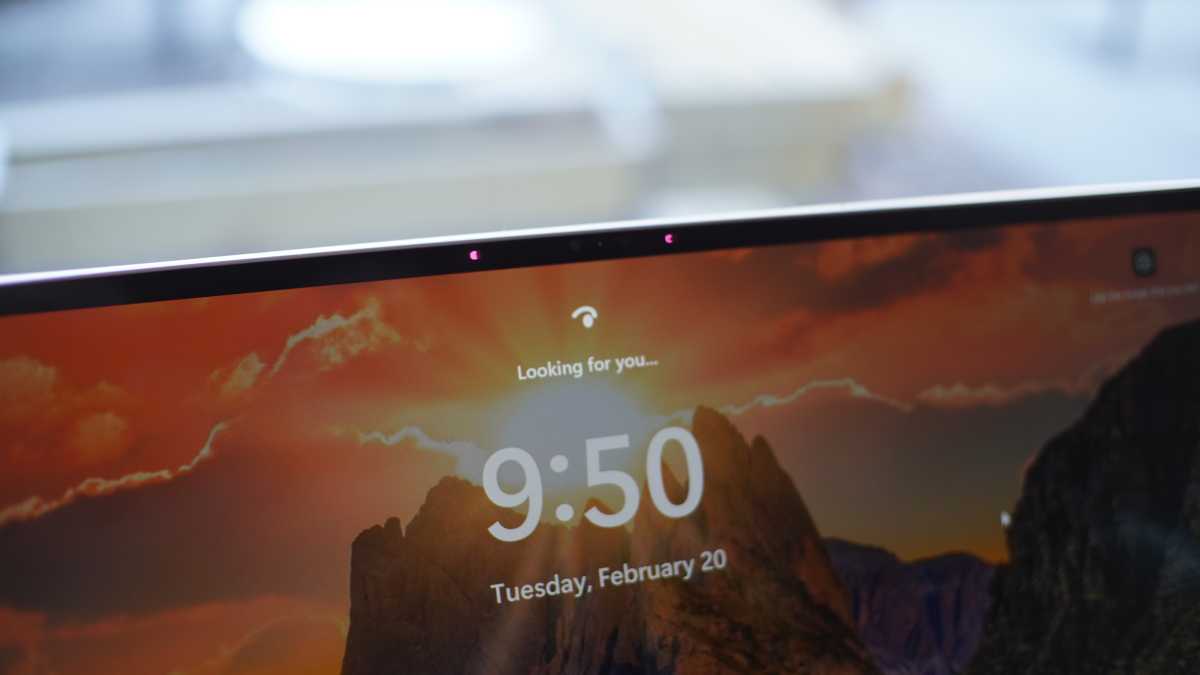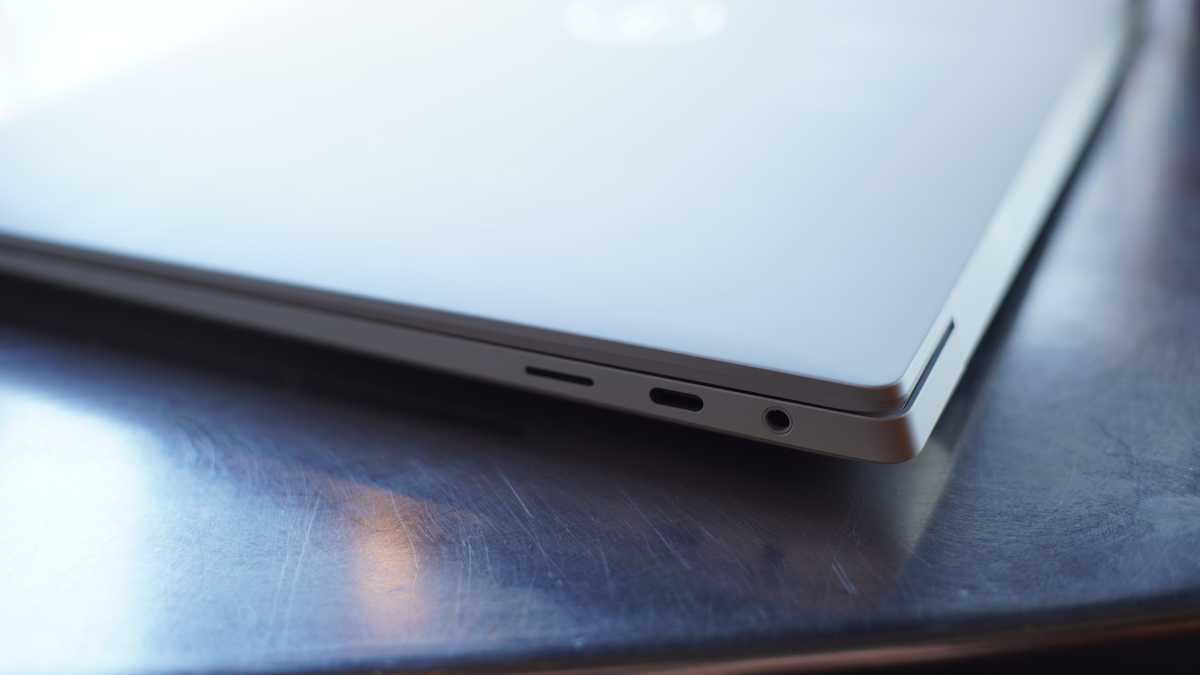Expert’s Rating
Pros
- Sleek design and sturdy build
- Wonderful OLED display
- Excellent CPU performance
- Great battery life
Cons
- GPU performance hampered by design
- Minimal ports for the size
- Expensive for the parts
Our Verdict
The Dell XPS 16 is a speedy machine and gentle on the eyes, so are plenty of much cheaper machines that don’t have as frustrating a keyboard or such a lacking port selection for pro users.
Price When Reviewed
$3,399
Best Prices Today: Dell XPS 16 (2024)
$1899
The Dell XPS 16 is the new big-screen productivity laptop for those looking for something a little more lavish than the typical business machines. It comes running on Intel’s new Core Ultra processors and offers up discrete GPU options for those who need even more power. Its sleek design shouldn’t be confused for a lightweight one, though, and the reality of its weight and pricey design put it at odds with lighter ultrabooks and more powerful workstation and gaming laptops alike. At $3,399, it’ll be a hard sell for anyone vaguely interested in good value.
Looking for more laptop options? Check out PCWorld’s roundup of the best laptops right now.
Dell XPS 16 (2024): Specs and features
The Dell XPS 16 comes in a variety of configurations with price and performance capabilities varying widely. At a baseline, it will offer an Intel Core Ultra 7 155H, which is a strong starting point, but it can go up to an Ultra 9 185H. Memory is available at 16GB, 32GB, and 64GB capacities, while storage starts out at 512GB but can go up to 4TB. The system can run on Intel Arc integrated graphics exclusively or a discrete GPU can be added with the RTX 4050, 4060, and 4070 as options. The final key confirmation option is display, with a 1920×1200, non-touch LED display available or the 3840×2400 OLED touchscreen available. The lowest of these configurations starts out at $1,899. Our test unit came in at $3,399 with storage, memory, GPU, and the display upgraded.
- CPU: Intel Core Ultra 7 155H
- Memory: 32GB LPDDR5x
- Graphics/GPU: Nvidia RTX 4070 (60-watt TGP, dGPU), Intel Arc (8 Xe cores, iGPU)
- Display: 16.3-inch 4K+ OLED, Touch
- Storage: 1TB PCIe Gen4 SSD
- Webcam: 1080p
- Connectivity: 3x Thunderbolt 4 / USB-C with Power Delivery and DisplayPort 2.1 Alternate Mode, 1x microSD card reader, 1x 3.5mm combo audio
- Networking: WiFi 7, Bluetooth 5.4
- Biometrics: Windows Hello fingerprint, facial recognition
- Battery capacity: 99 watt-hours
- Dimensions: 14.1 x 9.4 x 0.74 inches
- Weight: 5.03 pounds
- MSRP: $3,399 as-tested ($1,899 base)
Dell XPS 16 (2024): Design and build quality
IDG / Mark Knapp
Dell has gone all-in on its new design for the XPS series. Whereas prior models had a “Plus” in the name helping signify the shift toward a reimagined design of the workhorse series, now it’s just the mainline design. While the Dell XPS 16 still exhibits the company’s knack for build quality with a sleek — albeit simple and frankly a little MacBook-like — aluminum exterior that feels solid, it also boasts a design that’s as contentious for the eyes as it is for the hands.
The design of the keyboard and trackpad region sees the biggest changes. It has the new design, which situates a single piece of glass along bottom, so there’s no visual indication of where the trackpad begins and ends. The keyboard has a bunch of perfectly rectangular keys with a very minor dish and tight gaps between them, and the whole function row has been turned into ever-illuminated capacitive touch buttons a la Apple’s Touch Bar but without any of the multi-function magic.
This same design looked reasonably stylish on the earlier Dell XPS 13 Plus. But for the XPS 16, Dell was working with a bunch of extra space around the keyboard, where it decided to wedge two large speaker grilles that have the subtlest break from the design, but since the whole design is so minimalist, even the subtleties stick out. For this all white model, Dell’s white backlighting for the keyboard also ends up looking uneven and dirty underneath the keycaps.
Despite packing a high-power processor and discrete GPU into the system, the XPS 16 relies on just the slightest bit of visible venting to move air through the system, presumably taking some in through slits along the sides of the laptop and pushing it out through a strip under the edge of the display.
While the whole package has that typical, svelte ultrabook appeal to it, this is no thin-and-light laptop. It measures almost three-quarters of an inch thick and weighs a hair over five pounds.
Dell XPS 16 (2024): Keyboard, trackpad

IDG / Mark Knapp
Dell’s redesign comes with what might be the biggest trackpad in the business, but you wouldn’t know it. The all glass chin hides where it starts and ends completely. It encompasses the left Alt key and the new Windows Copilot key and reaches just a hair shy of the space bar and a half-inch short of the bottom edge. For some perspective, it’s larger than a Galaxy S24 Plus display. Impressively, even with its monolithic design, the trackpad still depresses naturally and provides a nice haptic click when it does so. It also has great palm rejection. While all that size is useful, especially for multi-finger gestures, it leaves a vagueness for where certain common actions are, like what region might result in a right click versus a left click.
The trackpad isn’t as problematic as the keyboard, though. Just typing, the keys feel a little too stiff, making repeated presses of the same key a little more difficult and error prone. The gaps between keys also makes it a little too easy to be on the right key but still catch the neighboring key on the downstroke. While I managed to reach a typing speed of 121 words-per-minute in Monkeytype with 97 percent accuracy, which is just shy of my fastest speeds, I was more often typing around 100 words-per-minute or suffering from significantly more typos as a result of the keyboard.
The function row is also an unfortunate change. If you ever have to use an actual F key like Alt+F4, the buttons up there will do the job, but you’ll have to count your way to the one you want (or hold the Function key). Combining them with actual keys on the keyboard, such as for Ctrl+Shift+Esc is also exceedingly awkward. And multiple taps are no better, making the relegation of the Delete key to that row an annoyance. Then there’s also the fact that this is a 16-inch laptop and it doesn’t have any extra keys to offer that you wouldn’t find on most 13-inch laptops — no extra navigation, no number pad, nothing extra.
Dell XPS 16 (2024): Display, audio

IDG / Mark Knapp
Things begin to take a turn back in Dell’s favor with the display on the XPS 16. It’s a gorgeous 16.3-inch OLED panel with a Gorilla Glass 3 cover that doesn’t suffer too much from glare, so you can save a bit of power by lowering the brightness levels. It can happily reach 400 nits while displaying SDR content and even exceed 600 nits showing HDR content. It has a wide color gamut, covering 100 percent of the DCI-P3 color space as well, making it wonderful for enjoying content. It even has Dolby Vision support, which only makes it all the more disappointing that it’s quite hard to access high-quality, HDR streams on a Windows PC compared to a phone or TV.
The OLED model includes a touchscreen, which exhibits a small array of dots that’s visible if you look very closely but otherwise blends in with the display. Even at a 3840×2400 resolution, Dell went for a fast refresh rate, too, reaching up to 90Hz and supporting Adaptive Sync down to 48Hz. How smooth that 90Hz will actually feel varies, though, as I noticed clunkier motion while running on integrated graphics and battery power.
Dell’s speakers are stellar. The system combines two 3-watt main drivers and two 2-watt tweeters. There’s occasional high-frequency rattling in the chassis while listening at even just 50% volume (noted during the intro to The Weeknd’s “I Feel It Coming”). Beyond that, the speakers sound quite excellent, with rich, full sound that really challenges what’s on offer from most laptops. The bass doesn’t boom, but it’s more present than you’d usually find. There’s even surprisingly compelling stereo separation for a laptop. It’s a really phenomenal job on Dell’s part here — maybe enough to help get over the fact this 16-inch laptop effectively has the same keyboard as a 13-inch model.
Dell XPS 16 (2024): Webcam, microphone, biometrics

IDG / Mark Knapp
The XPS 16 features a 1080p webcam that adds a bit more clarity than you’d usually see from the run-of-the-mill 720p cams out there. It still has that webcam-y quality, with bland color and noise in anything but the best lighting conditions. The camera also provides snappy facial recognition to unlock the laptop. The top right button on the keyboard has a fingerprint scanner that can also handle unlocking the computer, but I find the facial recognition usually beats it to the punch.
The mics do a good job picking up my voice, and provide a fullness and clarity that you won’t get from many Bluetooth headphones or earbuds. But it can sound a little boxed in compared to audio coming through a headset’s boom mic or a standalone mic.
Dell XPS 16 (2024): Connectivity

IDG / Mark Knapp
Prosumer laptops bring it when it comes to ports, especially bigger models, which have more room to squeeze in more ports. This helps them make up for their extra weight by negating the need for an external dongle. Right? Not for the XPS 16. It offers three fully features Thunderbolt 4 ports that’ll handle displays, file transfers, and power delivery, but you’re looking at external dongles if you want any HDMI or USB-A ports. Dell includes a super-light one in the package that gives you a USB-A and an HDMI port.
While there’s no knocking the capabilities of Thunderbolt 4, even just a single, proper USB-A port could have gone a long way toward supporting more peripherals. All Dell’s design work goes out the window as soon as an unsightly dongle is plugged in. Dell has included a headphone jack and a microSD card reader as well. But the port variety is quite the letdown, raising the question of who this laptop is really supposed to be for. Just for a quick comparison, the MSI Prestige 16 has one fewer Thunderbolt 4 port but adds USB-A, HDMI 2.1, Ethernet, and a full-size SD Card reader, and that 16-incher is actually lighter than Dell’s.
At least it has its wireless connectivity in point, supporting the new Wi-Fi 7 standard and Bluetooth 5.4, so it’s well prepared for the future.
Dell XPS 16 (2024): Performance
Dell has packed a good bit of muscle into the XPS 16, as it well should have for a laptop weighing over five pounds. It boasts the new Intel core Ultra 7 155H, a 16-core chip we recently saw in action in the MSI Prestige 16. The chip blends six performance cores, eight efficient cores, and an extra two low-power cores to provide speed and efficiency as the situation requires. That chip is backed by 32GB of LPDDR5x memory and a 1TB PCIe NVMe SSD. While the CPU includes Intel Arc integrated graphics, the XPS 16 also fits an Nvidia GeForce RTX 4070, albeit a power-limited, 60-watt version. Powerful as it might sound, it’s worth bearing in mind that this is a $3,399 configuration, so upper-tier performance should be par for the course.
In our PCMark 10 test, which measures general performance of the system as a whole across a broad range of office tasks, the Dell XPS 16 shows respectable performance. It falls short of the MSI Prestige 16 running similar hardware, but it plainly exceeds systems running on earlier Intel processors and even the Acer Swift Edge 16 running on an AMD CPU. This is a good indication that the Dell XPS 16 is up to the task of everyday computing in an office environment. In fairness to other machines, all of them are significantly lighter than the XPS 16, so they’re ability to keep cool under laid may be reduced.
When it comes to raw CPU performance, the Dell XPS 16 shows its strengths. Encoding a 32GB video file, it blew past the competition to finish the job in 951 seconds impressively beating the MSI Prestige 16 that had given it such a good run for its money in PCMark 10. We see that performance further exhibited in Cinebench — a CPU-focused test — where the Dell XPS 16 stayed at the front of the pack by a good margin. That went for Cinebench R15, R20, and R23. The Intel Core Ultra 7 clearly has some might and the XPS 16 is letting it run exceptionally well. This is all good news if you need CPU power for projects, as the Dell XPS 16 delivers.
The Dell XPS 16 tops that exceptional CPU performance off with the added benefit of a discrete GPU. With an RTX 4070 inside, even one limited to just 60 watts of power, the Dell XPS 16 obliterates the integrated graphics of these competitors. In both 3DMark Time Spy, a modestly demanding 3D rendering benchmark, the XPS 16 offered more than double the performance of the MSI Prestige 16’s Arc graphics and left Intel Iris Xe and AMD Radeon 780M graphics well behind. For gaming, video editing, 3D modeling, and more, that huge GPU advantage will be especially handy.
Dell’s against these ultrabook competitors being what it is, slim designs still come with compromises. For instance, the RTX 4070 running in the XPS 16 might blow away the integrated graphics of these competing systems, but if you look at a discrete GPU running in a system that puts a bit more emphasis on airflow, you’ll see a different story. For instance, I ran the same Time Spy benchmark on a Lenovo Legion Slim 5 14APH8 — a compact gaming laptop with an RTX 4060 in it — and it scored 9,238 points overall, narrowly edging out the Dell XPS 16 even though it uses a higher-tier GPU. It’s a similar story for the larger Lenovo Legion 5 Pro, which also runs its RTX 4060 faster than the XPS 16’s RTX 4070.
Dell XPS 16 (2024): Battery life
One benefit to Dell building a somewhat thick and heavy XPS 16 is that it could fit in a 99-watt-hour battery — as big as they get if you want to take them on an airplane, that comines with impressive efficiency for serious battery life.
In our standard battery test, looping a 4K copy of the Tears of Steel short film with the laptop’s display set to 250 nits and all keyboard backlighting and wireless radios disabled, the Dell XPS 16 ran for an average of 975 minutes — over 15 hours. Since the XPS 16 has an OLED display, it benefits from the black letterboxing around the video in this test, as those become pixels the display doesn’t have to illuminate — that’s free real estate. It’s still an impressive result for an OLED, as LED-backlit displays tend to have the advantage in battery life, and Dell even rates its non-OLED models for substantially longer battery life.
Curiously, Dell works against itself a bit. The laptop has a light sensor that is on by default and will adjust the screen brightness. In testing with this sensor enabled, our recorded battery life was only a little over 600 minutes (10 hours).
While this video playback runtime is impressive, it should be thought of as the high point for battery life. Working on the laptop will likely see less of the display occupied by black pixels (and far more of it occupied by white pixels in spreadsheets and documents), increasing the power draw of the display over all. Most laptops are pretty well optimized for video playback as well, whereas work is more likely to see the CPU and GPU ramp up and suck down plenty of power themselves. In practice, I could still easily make it through a workday on battery power with the XPS 16.
Dell XPS 16 (2024): Conclusion
The Dell XPS 16 has a lot to offer, but it’s a bit of a mixed up machine. It offers excellent CPU performance that can rival most other ultrabooks and it packs in a discrete GPU to boost graphical workloads. However, it comes at a high price for the blend of components and the GPU isn’t even able to reach its full potential in the XPS 16 chassis, which emphasis function over form a bit too much.
The hardware may be a marvel to look at, but it’s a little less of a joy to use. The display and speakers come together wonderfully, but this is no media consumption device. Ultimately, there are some premium parts packed into the XPS 16 and then a further premium slapped on top for the elegant design and bill of materials. This will put the machine at odds with buyers seeking any sort of value. For anyone who doesn’t need the discrete GPU, the MSI Prestige 16 is largely competitive and nearly half the price. And for those who do need real GPU power, they might be better served by a gaming laptop like the Lenovo Legion 5 Pro that’s much cheaper and, believe it or not, less than half of a pound heavier.


